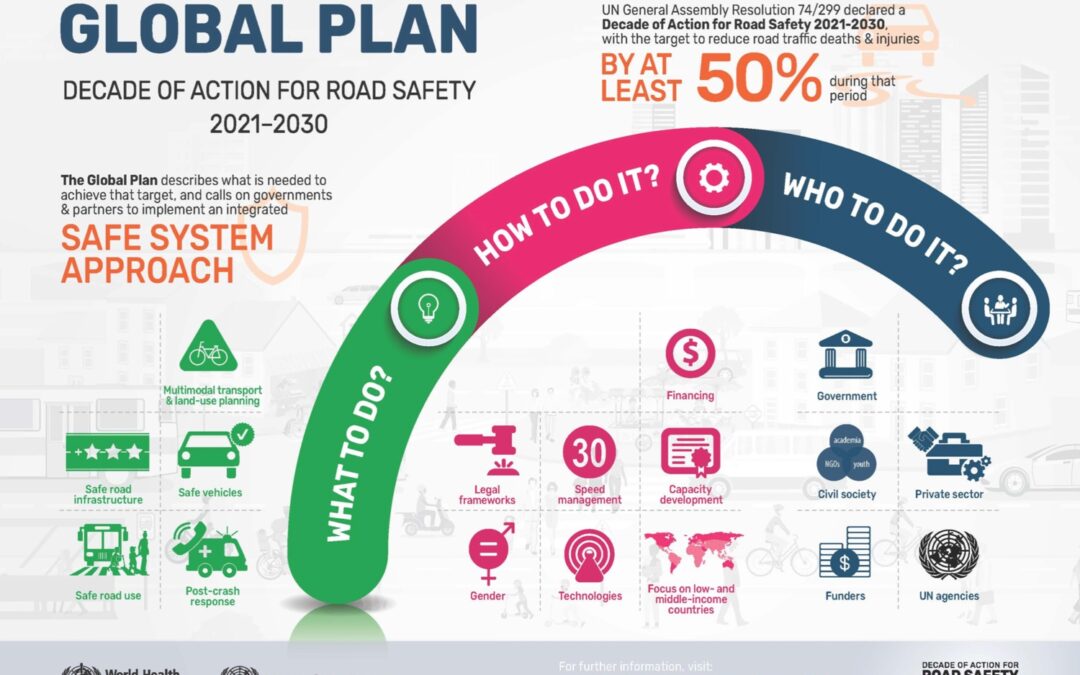Safe road infrastructure is a key focus of the Global Plan for the Decade of Action for Road Safety 2021-2030 alongside safe road use, safe vehicles, multimodal transport and land-use planning, and post-crash response. iRAP is ready to support partners and governments as they draw on the Global Plan to develop and implement national and local action plans to halve global road deaths and injuries by 2030.
The Global Plan was developed by the World Health Organization (WHO) and the United Nations Regional Commissions, in cooperation with partners in the United Nations Road Safety Collaboration and other stakeholders.
The Global Plan outlines the “what to do, how to do it and who to do it” to achieve the 12 Global Road Safety Performance Targets, calling on governments and partners to implement the Safe Systems Approach in the creation and implementation of strategies and programmes for road safety, sustainable mobility and urban design.
iRAP’s tools, training and support can assist partners in the implementation of actions which address 7 recommendations and 8 key themes in the Global Plan.
The following are examples of how iRAP and its partners can support countries implementing the Plan to achieve 3-star or better road safety.
| GLOBAL PLAN SAFER ROADS RECOMMENDATIONS AND THEMES | HOW IRAP AND ITS PARTNERS CAN HELP |
|
RECOMMENDATION 1: Develop functional classifications and desired safety performance standards for each road user group at the geographic land-use and road corridor level. |
|
|
RECOMMENDATION 2: Review and update legislation and local design standards that consider road function and the needs of all road users, and for specific zones. |
iRAP and its partners developed resources that help show how roads can be built to achieve Star Rating targets. For example:
|
|
RECOMMENDATION 3: Specify a technical standard and star rating target for all designs linked to each road user, and the desired safety performance standard at that location. |
|
|
RECOMMENDATION 4: Implement infrastructure treatments that ensure logical and intuitive compliance with the desired speed environment (e.g. 30 km/h urban centres; ≤ 80 km/h undivided rural roads; 100 km/h expressways). |
|
|
RECOMMENDATION 5: Undertake road safety audits on all sections of new roads (pre-feasibility through to detailed design) and complete assessments using independent and accredited experts to ensure a minimum standard of three stars or better for all road users. |
|
|
RECOMMENDATION 6: Undertake crash-risk mapping (where crash data are reliable) and proactive safety assessments and inspections on the target network with a focus on relevant road user needs as appropriate. |
|
|
RECOMMENDATION 7: Set a performance target for each road user based on the inspection results with clear measurable metrics at the road-attribute level (e.g. sidewalk provision). |
|
|
MULTIMODAL TRANSPORT AND LANDUSE PLANNING Multimodal transport and land-use planning is an important starting point for implementing a Safe System. |
|
|
CAPACITY BUILDING Capacity-building for road safety professionals should be given top priority. Training for professionals in allied fields (such as journalism) can be an effective means of strengthening advocacy and policy support for road safety efforts. |
|
|
LOW- AND MIDDLE-INCOME COUNTRIES Low- and middle-income countries (LMIC) account for more than 90% of all road traffic deaths … achieving the Decade target will require increased attention and support to these countries. Multinational corporations operating in low- and middle-income countries should monitor the safety of their operations… Through the establishment of regional networks and alliances, countries can increase their leverage… |
Examples of iRAP support and partnerships to eliminate high-risk roads in LMIC countries:
|
|
VULNERABLE ROAD USERS Road infrastructure must be planned, designed, built and operated to enable multimodal mobility, including shared/public transport, and walking and cycling. It must eliminate or minimize risks for all road users, not just drivers, starting with the most vulnerable. |
|
|
INTEGRATING TECHNOLOGY FOR INNOVATION THAT SAVES LIVES The physical and digital infrastructure needs for advanced driver assistance technologies and autonomous vehicles require specification. Adapting technologies for the Safe Systems – Vehicle-to-vehicle and vehicle-to-infrastructure communications can contribute to safer and more sustainable mobility. Managing the technological revolution and its potential impact on road safety… Increasing connectivity and other mobile technologies create new opportunities as well as challenges that require assessment and policies, regulations … |
|
|
STRATEGIC AND SUSTAINABLE INVESTMENT Longterm, sustainable investment is required for the development of safe road infrastructure as well as for interventions that can improve road safety. Road safety must be embedded in, and integral to, transport decision-making. |
|
|
YOUTH INCLUSION Young people play an important role in shaping the future transport system as the age group most affected by road trauma and the generation that will inherit the outcomes of decisions. As such they should be asked about their needs, and to help shape the system and generate ideas on how to better protect some of the most vulnerable. Meaningful engagement with young leaders can help foster greater ownership of the road safety issue as well as develop a new cohort of road safety advocates with a fresh perspective on the future of mobility. |
|
|
GENDER INCLUSION A gender perspective must be prioritised. For example, more women must be involved in the transport sector and its processes as decision-makers, engineers and designers … |
|
iRAP’s Strategy for 2030 is focussed on supporting Partnerships for 2030 Impact.
Thanks to the major donor support of the FIA Foundation, the charity looks forward to collaborating with partners in over 100 countries to implement the Global Plan and ensure that everyone can have safe journeys every day,.
Our work will support the UN General Assembly High-level Meeting in July 2022 which will focus on ‘The 2030 Horizon for Road Safety: Securing a Decade of Action and Delivery” and aims to mobilise political leadership, address gaps and challenges, promote multi-sectoral and multi-stakeholder collaboration, and assess progress made in attaining the objectives of the road safety-related SDG targets.


















